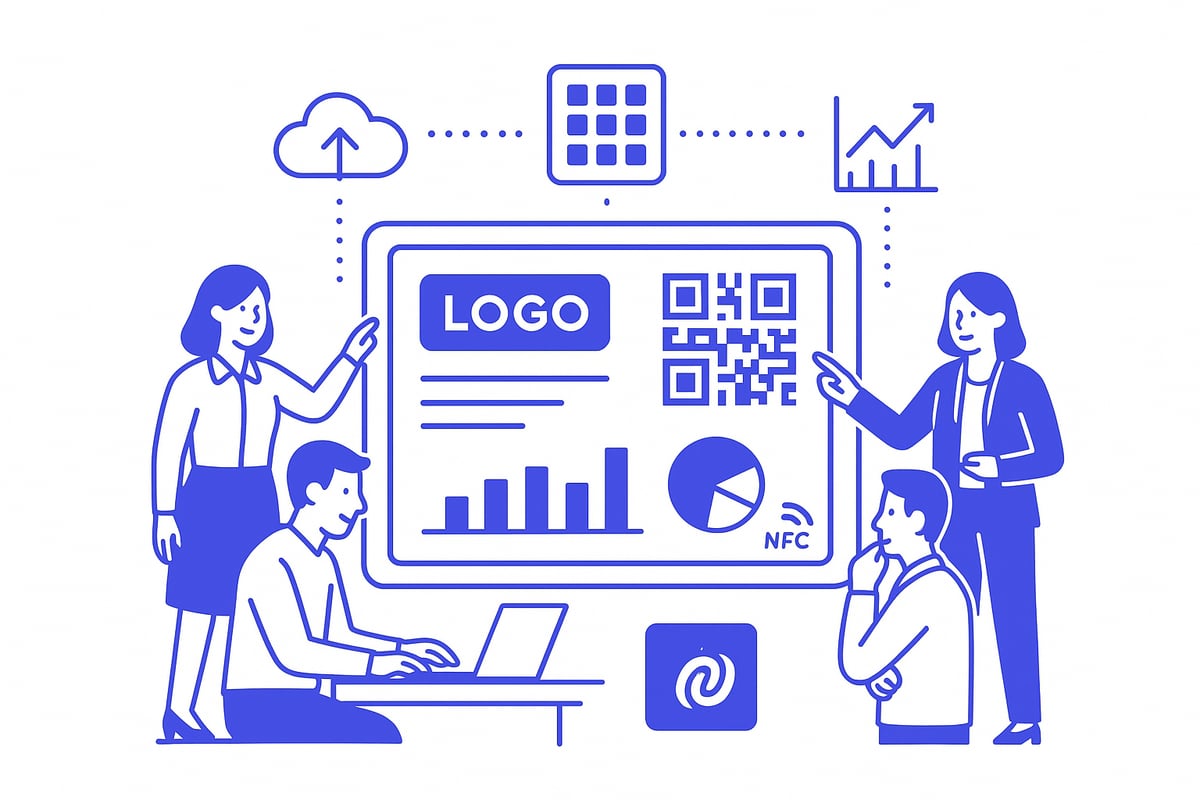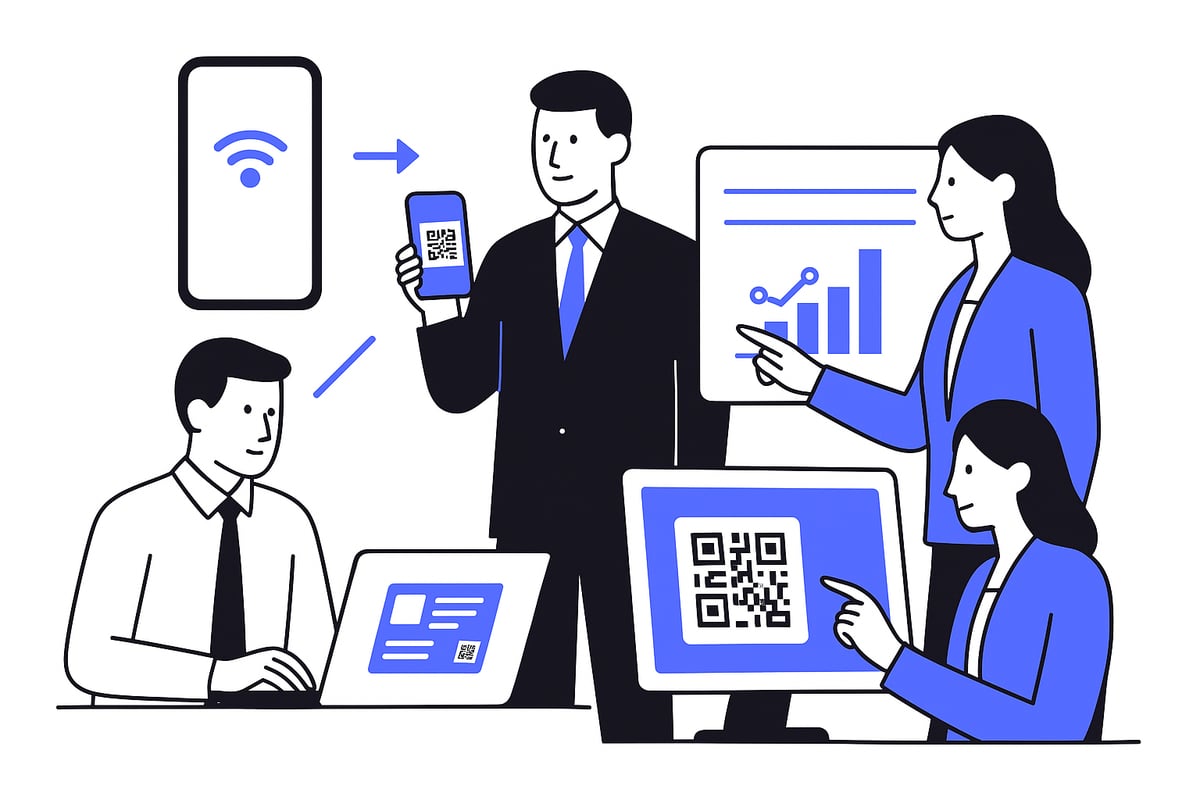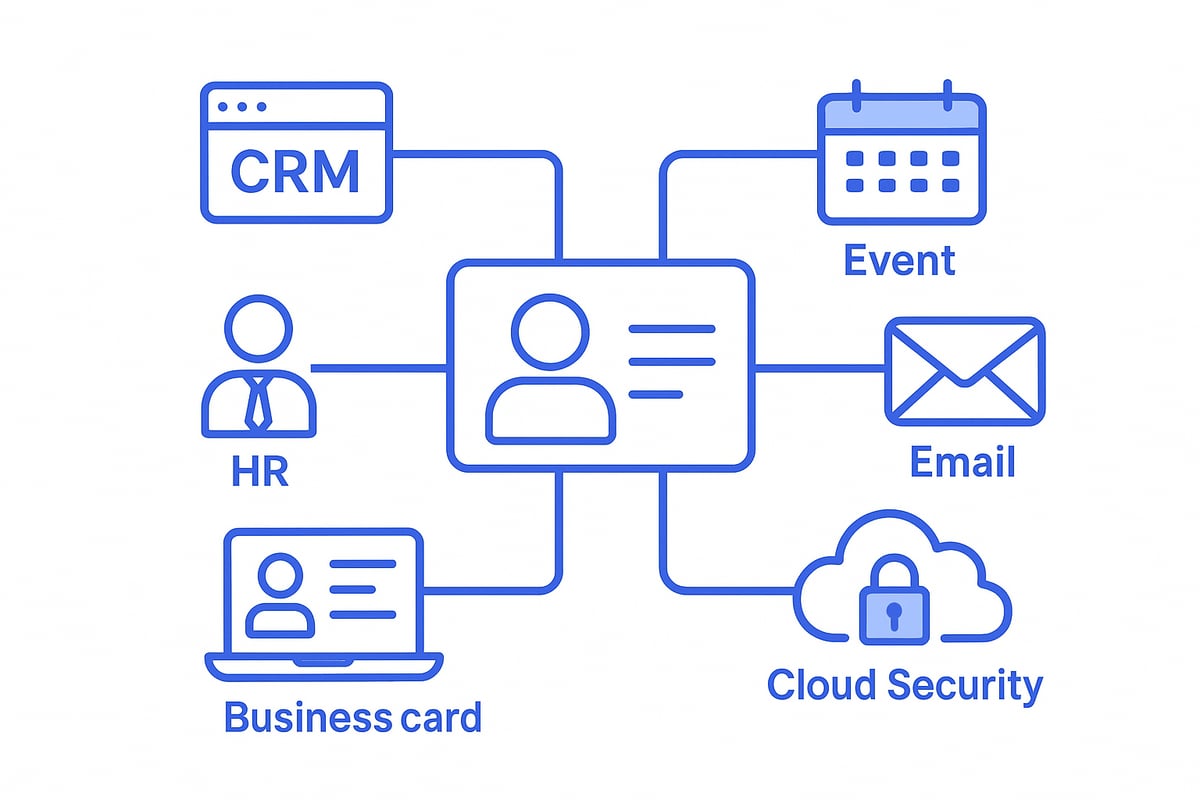Digital Business Card for Companies: The 2025 Success Guide
14 minutes
11th of October 2025
In this article:
- The Rise of Digital Business Cards for Companies
- Essential Features of a Digital Business Card Platform
- Step-by-Step Guide: Implementing Digital Business Cards Company-Wide
- Integrating Digital Business Cards into Corporate Ecosystems
- Measuring Success: ROI and Impact of Digital Business Cards
- Future-Proofing Your Company’s Networking Strategy
Are your company’s business cards still stuck in the past? In 2025, the digital business card for companies is transforming how organizations connect, share, and build relationships.
As businesses move away from outdated paper cards, modern teams expect eco-friendly, instantly updatable, and efficient networking solutions. Leading companies are adopting digital business cards to gain a competitive edge and streamline global connections.
With instant information updates, seamless sharing, measurable ROI, and stronger branding, the digital business card for companies offers clear advantages. This guide provides strategies, trends, and actionable steps to ensure your company thrives in the era of digital networking.
The Rise of Digital Business Cards for Companies
The shift to digital business card for companies is transforming how organizations connect, share, and build relationships. As the business landscape evolves, companies are rethinking traditional tools in favor of modern, efficient alternatives. This transformation addresses not only networking needs but also aligns with broader goals of sustainability, compliance, and measurable impact.

Evolution from Paper to Digital
Traditional business cards have long been the standard for corporate introductions, but their limitations are increasingly apparent. Paper cards are costly to print and distribute, difficult to update, and often end up forgotten or discarded—88% are thrown away within a week, according to Adobe.
Environmental concerns now drive organizations to seek greener alternatives. Many leading companies are reducing their ecological footprint by adopting digital business card for companies, directly supporting sustainability mandates. The rise of remote and hybrid work has also shifted networking needs, making digital solutions essential for seamless global connections. This evolution is a key step in modernizing corporate identity and aligning with digital transformation goals.
Key Benefits for Modern Enterprises
The adoption of digital business card for companies brings a suite of advantages. Real-time updates ensure contact information stays accurate, minimizing missed opportunities. Custom branding options allow interactive features like video introductions or product demos, enhancing corporate image.
Advanced analytics help enterprises track engagement and follow-up rates, while significant cost savings are realized by eliminating design, printing, and shipping expenses. Multinational firms now streamline global networking, unifying their teams under one digital system. In fact, companies report up to 630% more follow-ups with digital cards, as noted by OMR Reviews. These benefits deliver both operational efficiency and a measurable competitive edge.
Adoption Trends and Industry Data
The digital business card for companies is gaining momentum across sectors including finance, technology, healthcare, and events. Early adopters such as American Express GBT and Volkswagen Financial Services demonstrate the effectiveness of this transition.
According to Gartner, 37% of Fortune 500 companies plan to fully digitize business cards by 2025, reflecting a clear industry shift. Regional adoption varies: North America and Europe lead, while Asia-Pacific is rapidly catching up. Companies are leveraging digital solutions to optimize networking, foster collaboration, and stay ahead in a competitive marketplace.
Security, Compliance, and Sustainability
Security and privacy are top priorities for any digital business card for companies. Platforms must ensure GDPR compliance and secure management of sensitive contact data. Centralized control allows organizations to monitor sharing and access, reducing risk.
Sustainability is another driving force, with digital cards supporting ESG goals and public commitments to reduce waste. For example, global adoption of digital business cards can reduce annual paper waste by 2 million tons, according to Environmental Impact of Digital Business Cards. This shift demonstrates how companies can meet both regulatory and environmental expectations while modernizing their networking approach.
Overcoming Common Concerns and Barriers
Despite the benefits, some organizations are cautious about adopting digital business card for companies. Resistance to change can be strong, especially among teams accustomed to traditional methods. Ensuring accessibility for all employees, regardless of technical skill or location, is crucial.
Solutions now support offline sharing and international networking, making digital cards practical even without internet access. Hybrid events increasingly use NFC-enabled digital cards for instant, secure exchanges. By addressing these concerns, companies can ensure a smooth transition and maximize the value of their new digital networking tools.
Essential Features of a Digital Business Card Platform
Selecting the right digital business card for companies means evaluating platforms against a checklist of essential features. In 2025, enterprises require more than just a digital replacement for paper cards. They need a solution that brings branding, accessibility, integration, security, and data-driven insights together in one seamless experience.

Customization and Branding Capabilities
For any digital business card for companies, the ability to fully customize the design is vital. Enterprises need to present a consistent brand identity across every interaction, so platforms must support custom logos, fonts, and color schemes.
Interactive elements, such as video or photo backgrounds and clickable product demos, allow companies to stand out. For example, tech firms often introduce animated cards during major product launches to capture attention and drive engagement.
A robust digital business card for companies should provide easy-to-use templates, ensuring every employee’s card reflects the brand’s professionalism and values. This level of customization not only enhances first impressions but also strengthens brand recognition in competitive markets.
Multi-Channel Sharing and Accessibility
Modern networking demands flexibility. A digital business card for companies must support sharing via QR code, NFC, personal links, email signatures, and wallet integration. This ensures that contacts can be exchanged instantly, whether in-person or online.
Compatibility across all devices and platforms is essential. Sales teams, for instance, benefit from sharing their digital business card for companies through virtual backgrounds during video calls, reaching both remote and global audiences.
Companies should prioritize platforms that make sharing effortless, with no need for recipients to download an app. This inclusive approach eliminates barriers and accelerates connection-building in every business scenario.
Lead Capture and CRM Integration
Integrating lead capture tools transforms a digital business card for companies from a simple contact tool into a strategic asset. Features like built-in lead forms and scheduling links help organizations convert introductions into actionable sales opportunities.
Direct syncing with CRM systems such as Salesforce, HubSpot, or Microsoft Dynamics ensures that every captured lead is instantly available for follow-up. For example, marketing teams at industry events can use their digital business card for companies to gather contacts and schedule meetings on the spot.
Platforms offering seamless integration reduce manual data entry, minimize errors, and support the sales pipeline’s overall efficiency.
Team Management and Centralized Control
Managing hundreds or thousands of cards is a reality for large organizations. A digital business card for companies should provide centralized control for bulk onboarding, user provisioning, and template management.
HR departments can automate card creation for new hires, ensuring immediate access to branded cards. Centralized updates guarantee that company information stays current and compliant, even as teams grow or roles change.
Bulk actions and user management tools are crucial for maintaining consistency and reducing administrative overhead. This streamlines processes and ensures every employee represents the brand accurately from day one.
Analytics, Security, and Compliance
Real-time analytics are indispensable for tracking engagement and measuring networking ROI. A digital business card for companies must offer dashboards that show views, shares, and lead conversions, empowering leaders to refine strategies.
Security features, including GDPR compliance and role-based access controls, protect sensitive contact data. Enterprises routinely audit card usage to ensure data privacy and prevent unauthorized sharing.
As Digital Business Card Market Growth Projections highlight, analytics and compliance are increasingly prioritized by organizations adopting digital solutions. Choosing a platform that excels in these areas is essential for both operational success and regulatory peace of mind.
Step-by-Step Guide: Implementing Digital Business Cards Company-Wide
Adopting a digital business card for companies in 2025 is a strategic move that requires careful planning and execution. This step-by-step guide will help your organization navigate the transition smoothly, from initial assessment to ongoing optimization. Each stage is designed to maximize ROI, ensure compliance, and create a seamless experience for your teams.

Step 1: Assess Organizational Needs and Goals
Begin by identifying why your organization needs a digital business card for companies. Pinpoint core use cases such as sales, large-scale events, or internal networking. Involve key stakeholders from IT, HR, and marketing to align expectations and requirements.
Consider the diversity of your teams, especially if you operate globally. Multilingual support may be essential for international branches. Ask: Which departments will benefit most? Are there unique compliance or branding needs?
Document all requirements in a centralized checklist. This approach ensures your digital business card for companies implementation is tailored and future-proofed.
Step 2: Evaluate and Select the Right Platform
Next, evaluate platforms that offer the best digital business card for companies capabilities. Create a feature checklist: custom branding, CRM integration, analytics, and security are must-haves. Request demos and trial periods to compare usability and support.
Review market trends to understand which solutions align with your industry’s needs. Refer to Digital Business Cards Market Analysis 2025-2030 for insights on platform growth and competitive features.
Benchmark platforms based on security certifications, scalability, and client testimonials. The right digital business card for companies should fit seamlessly into your tech ecosystem.
Spreadly: A Modern Solution for Companies
Spreadly stands out as a leading digital business card for companies, offering instant sharing, robust custom branding, and integrations with CRM and HR systems. The platform’s lead capture and compliance features meet enterprise standards.
Major organizations like American Express GBT and TeamViewer have adopted Spreadly for its no-app setup and GDPR compliance. With a setup time of just two minutes, Spreadly enables companies to deploy a digital business card for companies at scale. The free-to-start model encourages rapid experimentation and adoption.
Step 3: Plan Rollout and Onboarding
Once you select a digital business card for companies platform, create branded templates for each department or region. Use HR integrations to automate onboarding, reducing manual work and ensuring consistency.
Communicate the benefits and process to employees through internal channels. Provide clear training materials and FAQs to address common questions. For large enterprises, staggered rollouts or pilot programs can help fine-tune your approach.
A well-structured onboarding process ensures every employee has access to their digital business card for companies quickly and efficiently.
Step 4: Integrate with Existing Workflows
Integrating your digital business card for companies with existing workflows is crucial for adoption. Connect the platform with CRM and HR systems to automate contact updates and provisioning.
Embed cards in email signatures, virtual meeting tools, and digital wallets for easy sharing. For example, syncing new contacts directly to Salesforce or Google Contacts streamlines follow-up.
This seamless integration ensures your digital business card for companies becomes a natural part of everyday business processes, maximizing its impact.
Step 5: Launch, Monitor, and Optimize
With everything in place, launch your digital business card for companies company-wide. Encourage teams to share feedback and report any issues. Use built-in analytics to monitor adoption rates, engagement, and lead capture performance.
Regularly review data to identify bottlenecks or areas for improvement. Optimize templates, workflows, or integrations based on real-world usage. As new teams or regions come on board, scale your digital business card for companies strategy accordingly.
Step 6: Ensure Ongoing Security, Compliance, and Support
Security and compliance should be top priorities for any digital business card for companies deployment. Conduct regular audits to confirm GDPR or CCPA compliance and ensure data privacy controls are up to date.
Stay informed about evolving privacy laws and update your policies as needed. Provide ongoing support and resources for employees, including helpdesk access and refresher training.
By maintaining a proactive approach, your organization ensures the long-term success and security of its digital business card for companies initiative.
Integrating Digital Business Cards into Corporate Ecosystems
Seamless integration is the cornerstone of maximizing value from a digital business card for companies. By connecting these platforms with existing corporate systems, organizations can unlock new efficiencies, improve data flows, and elevate the entire networking experience.

CRM and Marketing Automation Integration
Integrating a digital business card for companies with CRM and marketing automation tools transforms every new contact into a valuable data point. When leads and contacts flow automatically into Salesforce, HubSpot, or Microsoft Dynamics, teams can:
- Trigger instant follow-ups and nurturing campaigns
- Eliminate manual data entry errors
- Gain real-time visibility into engagement
AI-powered personalization is also accelerating these benefits. According to AI Integration in Digital Business Cards, advanced platforms now use artificial intelligence to tailor content and automate lead qualification, further increasing ROI. This integration gives marketing and sales teams a competitive edge, ensuring no opportunity slips through the cracks.
HR and User Management Systems
A digital business card for companies should integrate with HR and user management platforms for streamlined onboarding and offboarding. Connecting with systems like Microsoft Entra ID or BambooHR enables:
- Automated provisioning and deactivation of employee cards
- Centralized updates to staff information
- Consistent branding across departments
This reduces administrative overhead and ensures every employee's digital identity is always current. HR teams can manage hundreds of cards with just a few clicks, supporting rapid growth and organizational changes.
Event and Conference Solutions
Event networking is transformed by a digital business card for companies, especially when paired with NFC-enabled cards and instant lead capture. Integrating with event management tools allows organizations to:
- Instantly share contact details with a tap or scan
- Capture and qualify leads on the spot
- Sync attendee data with CRM and marketing platforms
Companies using digital cards at global trade shows report higher engagement and faster follow-ups. This technology empowers teams to stand out and maximize every networking opportunity.
Email, Wallet, and Virtual Collaboration Tools
Embedding a digital business card for companies into email signatures, virtual meeting platforms, and digital wallets enhances accessibility and professionalism. Key integration points include:
- Automatic distribution in corporate email signatures
- Quick sharing during video calls via clickable backgrounds
- Adding cards to Apple Wallet or Google Wallet for instant access
Remote and hybrid teams especially benefit, as they can share contact details seamlessly regardless of location. This fosters connection and efficiency across distributed workforces.
Data Security, Privacy, and Compliance Management
Maintaining trust and compliance is essential when deploying a digital business card for companies. Integrations with security and compliance tools allow organizations to:
- Enforce GDPR and regional data privacy policies
- Control access and usage based on user roles
- Audit card usage to meet internal and external standards
Centralized policy management ensures sensitive information stays protected at all times. Companies can confidently scale digital networking while meeting evolving regulatory demands.
Measuring Success: ROI and Impact of Digital Business Cards
Understanding the return on investment for a digital business card for companies is essential for long-term success. By focusing on clear performance indicators, cost efficiency, brand consistency, and real-world outcomes, organizations can make data-driven decisions and maximize the value of their networking tools.
Key Performance Indicators (KPIs) to Track
Tracking KPIs is crucial to measure the effectiveness of a digital business card for companies. Key metrics include:
- Views and shares of each card
- Lead form submissions and contact saves
- Follow-up actions and conversion rates
Companies that monitor these indicators see greater engagement and improved networking outcomes. For example, businesses report up to 38% higher engagement rates when they transition to digital cards. Consistent tracking helps leadership identify trends, optimize content, and ensure the digital business card for companies delivers measurable value.
Analyzing Cost Savings and Efficiency Gains
Switching to a digital business card for companies brings significant cost and time savings. Consider the following comparative summary:
| Expense Area | Traditional Cards | Digital Cards |
|---|---|---|
| Printing & Shipping | High | None |
| Design Updates | Recurrent cost | Instant, free |
| Distribution | Manual, slow | Automated, fast |
Enterprises often save thousands annually by eliminating printing and shipping costs. Additionally, updating contact information becomes seamless, reducing administrative overhead. The digital business card for companies streamlines processes, allowing teams to focus on building relationships rather than managing logistics.
Enhancing Brand Visibility and Consistency
A digital business card for companies ensures every employee represents the brand consistently across all channels. Benefits include:
- Unified branding: logos, colors, and messaging
- Professional presentation at events and meetings, which they can create with the help of an AI presentation maker
- Enhanced perception with interactive features
Standardized digital cards help multinational teams maintain a cohesive image, regardless of location. This consistency reinforces trust and recognition, supporting long-term business growth. The digital business card for companies becomes not just a networking tool but a strategic branding asset.
Real-World Case Studies and Data
Early adopters of the digital business card for companies have seen impressive results. For instance, TeamViewer and Telekom reported millions of cards shared globally and a surge in captured leads at events. According to industry reports, organizations leveraging digital cards experience higher follow-up rates and improved networking efficiency. These real-world outcomes demonstrate the tangible impact and ROI that digital business card for companies can deliver in today's corporate landscape.
Future-Proofing Your Company’s Networking Strategy
Staying ahead in corporate networking requires a proactive approach. As the business landscape evolves, companies must ensure their tools and strategies are adaptable and resilient. A digital business card for companies is more than a short-term fix, it is a foundation for ongoing growth and innovation.
Emerging Trends in Digital Networking
The future of networking is being shaped by rapid advances in technology. Modern solutions now include AI-powered business card scanners that automatically extract and organize contact data. Companies are also experimenting with digital business card for companies integrations in AR and VR platforms, enabling immersive virtual networking experiences.
Some organizations are piloting virtual business card exchanges at metaverse events, where professionals connect in 3D environments. These innovations are making networking more interactive and personalized, setting the stage for the next generation of digital engagement.
Sustainability and Corporate Social Responsibility
Sustainability is now a strategic priority for many enterprises. By adopting a digital business card for companies, organizations can significantly reduce paper usage and contribute to their environmental, social, and governance (ESG) goals.
Digital solutions also allow companies to track and report sustainability metrics, supporting transparency in public ESG reporting. Many enterprises have already achieved their paperless targets using digital business cards, demonstrating commitment to responsible business practices and strengthening their brand reputation.
Preparing for Global and Hybrid Workforces
The modern workforce is more distributed and diverse than ever before. A digital business card for companies offers multilingual support, making it easy for international teams to connect and share information seamlessly.
These solutions also cater to remote, hybrid, and mobile employees, ensuring consistent access to networking tools wherever they work. Companies are rolling out digital business cards across multiple continents, streamlining global onboarding and fostering stronger cross-border collaboration.
Continuous Innovation and Adaptability
Remaining competitive requires a commitment to continuous improvement. Leading platforms for digital business card for companies regularly introduce feature updates that address emerging needs and technologies.
Companies are leveraging API integrations to create custom workflows, connecting digital business cards with CRM, HR, and marketing systems. By staying adaptable and embracing new networking technologies, organizations can future-proof their corporate networking strategy and maintain a decisive edge in their industry.
You’ve seen how digital business cards are transforming the way companies connect—making networking more efficient, eco-friendly, and impactful. If you’re ready to experience these benefits firsthand and see how features like instant updates, rich media, and seamless integrations can elevate your brand, I encourage you to Try for free. With no payment required to start, you can explore the full potential of modern, customizable business cards and discover how simple it is to empower your team for success in 2025 and beyond.






